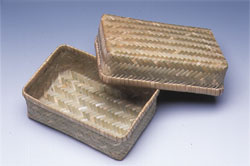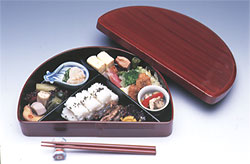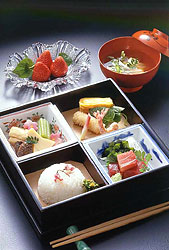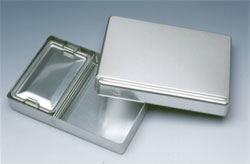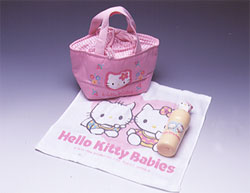|
A bento box is a compact container
designed to hold a single serving of rice and several side dishes. In ancient
times, lunches were wrapped using such materials as oak leaf, magnolia leaf,
bamboo leaf, and bamboo sheath. Later, wooden boxes came into use. In some
regions, fancy bento boxes with lids were made by interweaving thin
strips of bamboo or willow, or by bending strips of wood into shape. These
bento boxes are still produced and sold today as traditional handicrafts.
During the Edo period, prosperous merchants
packed lavish assortments of their favorite foods into fancy tiered boxes
to enhance the pleasure of flower viewing or theater going. From this
time forth, bento served on special occasions - such as during
celebrations in the home, at Buddhist memorial services, and for entertaining
guests - evolved into a unique, sophisticated art form. They were used
particularly often in the tea ceremony.
One traditional type of bento box still
in use today is the hangetsu (half moon) style container, said to
have been favored by Sen no Rikyu, who established the art of the tea ceremony
in the latter half of the sixteenth century. Another is the chabako
(tea box) bento. The tea box is a vessel for storing the implements
needed in an open-air tea ceremony, and this type of bento uses the
chabako as the container. And there is the Shokado bento,
inspired by the partitioned paintboxes that Shokado Shojo, a monk and painter
of the early Edo period, used regularly. The food that goes inside these
boxes varies according to the season and the occasion, but the food is always
beautiful to look at as well as delicious to taste.
In Japanese restaurants, bento boxes
are used to present individual servings of kaiseki ryori, the exquisite
food served at traditional Japanese sit-down parties. These restaurants
use bento boxes mainly as a means of serving individual meals compactly,
rather than as a convenient means of carrying food outside the home.
Modern bento boxes are made of a variety
of materials, including wood, metals such as anodized aluminum, and plastic.
They are usually rectangular, oval, or circular in shape. The wide range
of bento boxes available today includes watertight vessels that can
be used for foods with liquid content, containers that keep foods hot, and
minitrunks that fit small drink bottles inside.
Many designer bento boxes, as well as
boxes decorated with popular characters such as Hello Kitty, are on the
market. Some people like to go all out and buy matching chopsticks, silverware,
and carrying cases to go with their bento boxes.
|
